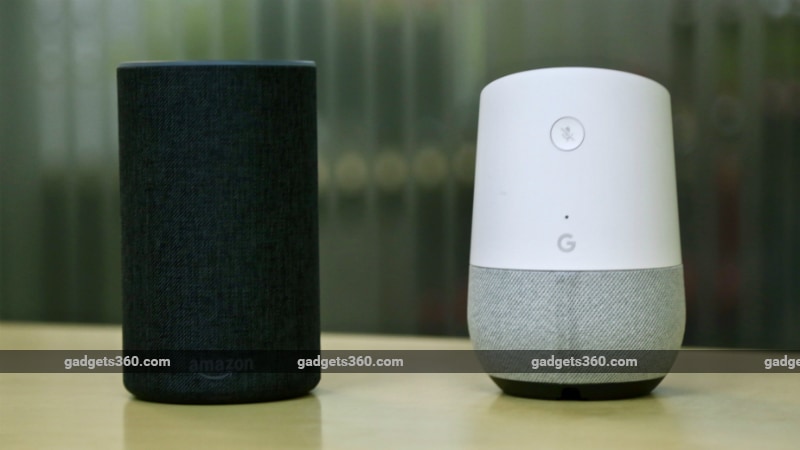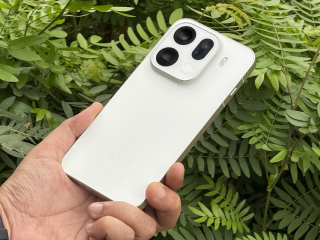- Home
- Smart home
- Smart home Features
- Amazon Echo vs Google Home: Which Smart Speaker Is Made for India?
Amazon Echo vs Google Home: Which Smart Speaker Is Made for India?

Smart speakers are all the rage these days. The voice assistants from Mountain View and Seattle in the US are engaged in a battle to dominate our homes in India. Smart speakers are an extremely divisive product category with some people swearing by them and others seeing them as redundant and just a fad. Nearly six months after the launch of Amazon's Echo lineup of smart speakers, Google has brought the Google Home and Google Home Mini to India. The Google Home and Amazon Echo are priced at Rs. 9,999 and can be bought online via Flipkart and Amazon India respectively. Both can also be found offline at Croma, Reliance Digital, and other retail outlets.
We spent the past couple of weeks pitting the Google Home against the Amazon Echo. Does the new kid on the block have what it takes to compete with Amazon's offering? Let's find out.
Amazon Echo vs Google Home: Design
In terms of design, both smart speakers are as different as chalk and cheese. While the Amazon Echo looks and feels industrial, mechanical and utilitarian, Google has gone for a softer, more rounded, and homely aesthetic with the Google Home. Both smart speakers are immobile and powered by proprietary power adapters.
The Google Home has a very minimalist, simple and inconspicuous appearance. The top half is made of white plastic and the bottom is a removable panel covered in fabric. While Google offers a variety of bases with different metal and fabric finishes in Europe and the United States, Indian buyers will have to make do with the one that comes in the box
The Amazon Echo has a very basic, no-nonsense design, with its entire front fascia covered in fabric. There are four buttons and an LED ring on the top. While there is no mistaking the Amazon Echo for anything other than a portable speaker, many of our friends thought the Google Home was a fancy lamp or air freshener at first glance. Google itself says that the Google Home's design was inspired by glasses and candles.
![]()
This approach is carried forward to the controls as well, with the Echo having mechanical buttons and the Google Home sporting a touch panel and four LEDs that give visual feedback. The multi-function button on the Echo can be used to bring up Alexa without saying anything, which comes in handy when the device is within arm's reach. The Google Home can be silenced by tapping the touch panel once, which is an incredibly convenient feature and one we sorely missed on the Amazon Echo.
When it comes to smart speakers, privacy is a big concern for many people. The Google Home and Amazon Echo are fundamentally linked to your Google and Amazon accounts respectively, which can put some people off. Even though both companies claim that nothing is sent to their servers till the trigger words, ('OK Google' in the case of Google Home and 'Alexa' in case of Amazon Echo) are spoken out loud, many folks are still wary of Amazon and Google listening in on their conversations. To address this, both speakers have switches to disable their microphones.
Amazon Echo vs Google Home: Capabilities
The Google Home and the Amazon Echo harness Google Assistant and Alexa respectively in order to play songs, answer all sorts of questions, tell you sports scores, look up the weather, and even tell the occasional joke.
While the Amazon Alexa app is more intuitive at times and has a flashier user interface, the Google Home application is more stable. There is a perceptible delay when changing settings in the Amazon Alexa app, which becomes a little infuriating at times. Setting up both smart speakers is extremely simple though. As long as you have a fast and reliable Wi-Fi connection, both apps will recognise the smart speakers in a jiffy and walk you through a few simple steps.
Both Alexa and Google Assistant handle basic basic tasks - such as setting reminders and alarms, suggesting restaurants, answering trivia questions - with ease, with the latter having the distinct advantage of being more conversational and context-aware. As a result, conversing with the Google Home feels more natural and fluid as compared to the Echo, which feels stilted and mechanical at times.
Asking Google's smart speaker "Who is the Chief Minister there" after asking about the weather is in New Delhi yields the name of the CM of Delhi. You can then take things a step further and ask "Which party is he from" or "How tall is he", and the Google Assistant understands that you're referring to the same person and responds accordingly. Alexa simply lacks such contextual understanding of text flow. That said, the Google Assistant has the propensity to default to Google Search for too many queries. It also won't let you place calls or send text messages via the Google Home. The Amazon Echo in comparison can be used to call your friends (with an Echo device or Alexa app installed), provided you give Alexa access to your contacts. It also does a better job with local queries, especially those related to Bollywood and can even read your Kindle books aloud.
![]()
Another advantage of the Amazon Echo is 'skills', which allow third-party applications to add functionality to Alexa. Over the last couple of months, Amazon has put in place a robust ecosystem of these skills, tying up with players across multiple categories. In India, these include Uber, Ola, Ixigo, GoIbibo, Freshmenu, Cleartrip, UrbanClap, and Jet Airways. As such, the Echo can be used to book cabs, order food, book flights and hotels, and even book an electrician.
Alexa's voice sounds more natural than Google Assistant's Indian accent, which comes across as forced and robotic. The Google Home has the ability to recognise up to six different users and give different responses to each of them. The Echo in comparison adopts a 'one-for-all' approach.
In our experience, both smart speakers understood Indian accents quite well and successfully recognised the names of Indian artistes and songs such as 'Harris Jayaraj' and 'Dil Gira Daftan'. At the moment, the Echo understands Hindi, Tamil, Telugu, Kannada, Malyalam, and Punjabi proper nouns when used in an English sentence. For example, you can ask Alexa to add 'atta' to your shopping list. Neither smart speaker supports Hindi input at the moment, but Google is planning to introduce the language later this year, which will give the Google Home a leg up over Amazon's offering.
The Echo's smart home capabilities are also more developed in India. The Philips Hue ecosystem is one of the only smart home players supported by the Google Home at the moment. In comparison, the Amazon Echo supports smart home products made by Syska, Oakter, TP-Link, D-Link, and LIFX, as well as Philips.
![]()
Both smart speakers can be used to play games which is a great way to impress friends and kill some time. The Google Home has only two games on offer at the moment with more expected in the future. The Echo on the other hand has a much wider ecosystem of third-party games such as 'IPL 2018', 'Rock Paper Scissors', 'Simon Says' and more. At the time of writing, the Amazon Alexa app had 4,484 skills listed under the category of 'Games, Trivia & Accessories'.
Both smart speakers allow sequences of multiple actions to be clubbed together into 'routines', so, for example, you can have one that reads out the weather, turn your lights on, and play a playlist of relaxing songs, all in one go. In our experience, setting up routines with the Amazon Alexa app was quite a bit more intuitive and user-friendly. The Echo can also be used to buy products directly from Amazon, which is a rather nifty feature to have - if dangerous for the wallet.
As noted in our Google Home review, one of the best uses of a smart speaker is having it read the top news stories of the day aloud in the morning. Both smart speakers allow news sources to be customised via their respective applications but the Google Home is currently limited mostly to international sources such as Forbes, BBC, and Al-Jazeera. The Echo in comparison can pull content from international sources as well as a host of local media publishers including The Quint, NDTV, Gadgets 360, and so on.
Amazon Echo vs Google Home: Sound quality and performance
While the Echo has seven far-field microphones, the Google Home makes do with two. In our experience, the Echo did a slightly better job of recognising our voice from the far side of the room. The Home in comparison struggled slightly when music was playing at full volume.
Both smart speakers can play songs on request from various streaming services. The Google Home has Google Play Music, Gaana, and Saavn in its roster, and the Echo supports Amazon Music, TuneIn Radio, Gaana and Saavn. Both do good jobs of recognising the names of Indian songs and artistes, and both can also play personal playlists from any of the services named above.
Neither smart speaker can compare to similarly priced Bluetooth speakers such as the JBL Charge 2+ or Bose SoundLink Color 2 in terms of the quality of sound on offer. If audio quality is what matters most and you can live without smart features, 'old-fashioned' Bluetooth speakers are the way to go.
![]()
Between the two, the Google Home outperforms the Echo on the audio front. Both are more than capable of filling a moderately sized room with sound thanks to their 360-degree speakers that fire in all directions. However, the Home sounds warmer and produces tighter and punchier bass. Additionally, it distorts less at high volume, and its soundstage is wider.
Clarity and instrument separation are lacking with both speakers, and the mids are quite suppressed in the sound mix. To give credit where it is due, the Echo does a better job with the highs, which are sparkly and never become hissy or sibilant. Call quality is excellent on both the Google Home and Amazon Echo - with little to distinguish between them.
The Google Home and Amazon Echo can be used as regular Bluetooth speakers and paired with your smartphone or laptop. Audio quality does dip in this mode, as sound transmitted over Bluetooth faces higher levels of compression than Wi-Fi. There is no mention of either speaker supporting the higher quality aptX or AptXHD compression formats. Both can be connected to other Bluetooth-enabled speakers - a nifty way to upgrade their rather limited sound quality. The Echo also has a 3.5mm audio output, which is a feature missing from both the Google Home and Google Home Mini.
If you have a Google Chromecast linked to your television, you can simply ask Google Home to cast a movie or TV show to it, and even control playback with your voice. In a similar vein, the Echo can send movies and television shows to the Fire TV Stick, although this feature is not officially available in India yet.
Verdict
The Google Home is compact and minimalist, and sounds better than the Amazon Echo. Google Assistant is also more context-aware than Alexa, which makes conversing with it feel more natural. However, the Google Home falters a bit as a smart speaker. Its capabilities are limited at the moment, especially when it comes to localisation. The Amazon Echo has had a head-start in the market and has made good use of it.
Simply put, there is a lot more that you can achieve with the Amazon Echo compared to the Google Home at the moment. The Echo does a better job with local queries, can place calls and send messages, and sounds more natural. The fact that its capabilities can be enhanced with skills is the icing on the cake. That said, Google has just begun its smart speaker innings in India, and there is a lot of potential waiting to be tapped.
Catch the latest from the Consumer Electronics Show on Gadgets 360, at our CES 2026 hub.
Related Stories
- Samsung Galaxy Unpacked 2025
- ChatGPT
- Redmi Note 14 Pro+
- iPhone 16
- Apple Vision Pro
- Oneplus 12
- OnePlus Nord CE 3 Lite 5G
- iPhone 13
- Xiaomi 14 Pro
- Oppo Find N3
- Tecno Spark Go (2023)
- Realme V30
- Best Phones Under 25000
- Samsung Galaxy S24 Series
- Cryptocurrency
- iQoo 12
- Samsung Galaxy S24 Ultra
- Giottus
- Samsung Galaxy Z Flip 5
- Apple 'Scary Fast'
- Housefull 5
- GoPro Hero 12 Black Review
- Invincible Season 2
- JioGlass
- HD Ready TV
- Laptop Under 50000
- Smartwatch Under 10000
- Latest Mobile Phones
- Compare Phones
- OPPO Reno 15 Pro Max
- Honor Win RT
- Honor Win
- Xiaomi 17 Ultra Leica Edition
- Xiaomi 17 Ultra
- Huawei Nova 15
- Huawei Nova 15 Pro
- Huawei Nova 15 Ultra
- Asus ProArt P16
- MacBook Pro 14-inch (M5, 2025)
- OPPO Pad Air 5
- Huawei MatePad 11.5 (2026)
- Xiaomi Watch 5
- Huawei Watch 10th Anniversary Edition
- Acerpure Nitro Z Series 100-inch QLED TV
- Samsung 43 Inch LED Ultra HD (4K) Smart TV (UA43UE81AFULXL)
- Asus ROG Ally
- Nintendo Switch Lite
- Haier 1.6 Ton 5 Star Inverter Split AC (HSU19G-MZAID5BN-INV)
- Haier 1.6 Ton 5 Star Inverter Split AC (HSU19G-MZAIM5BN-INV)
















